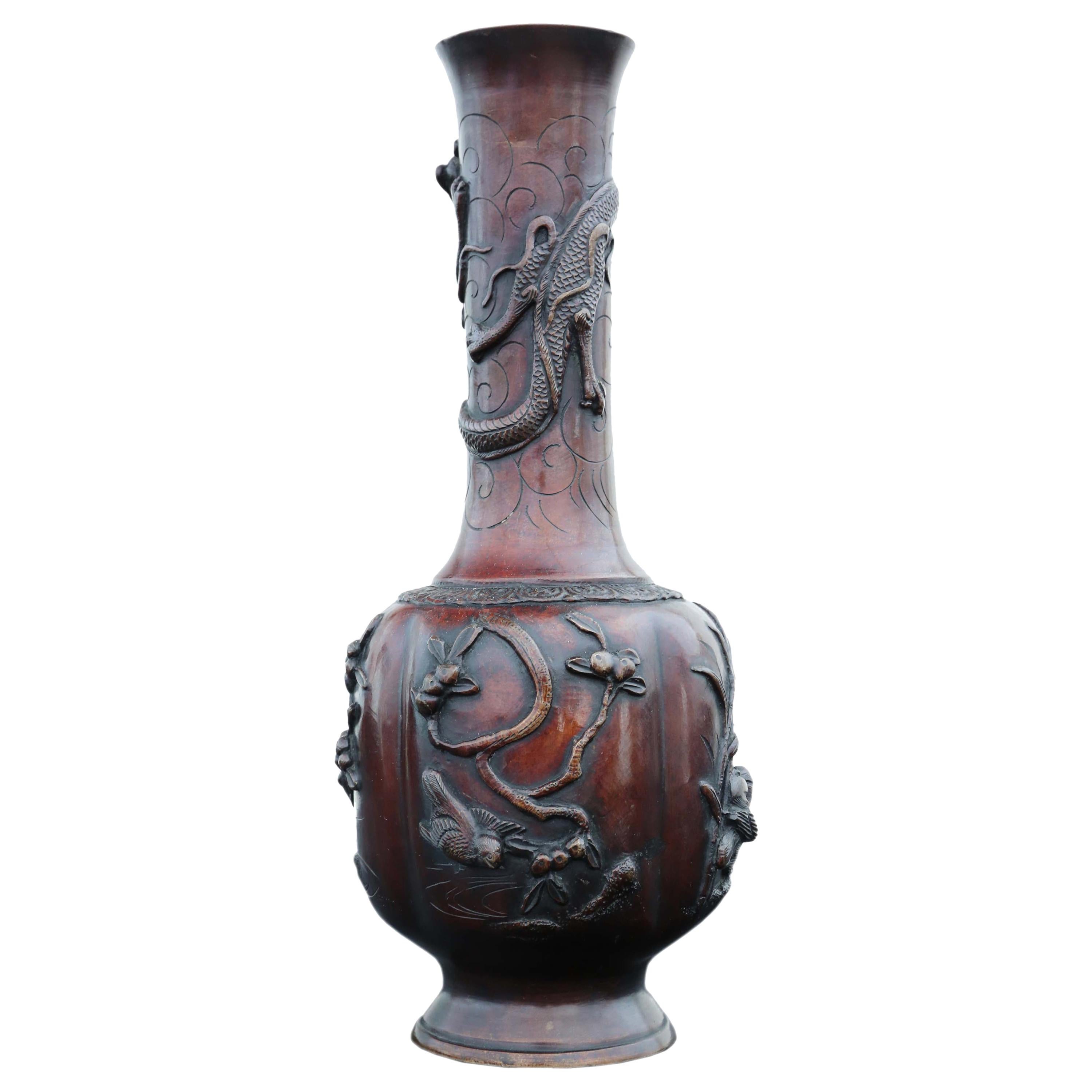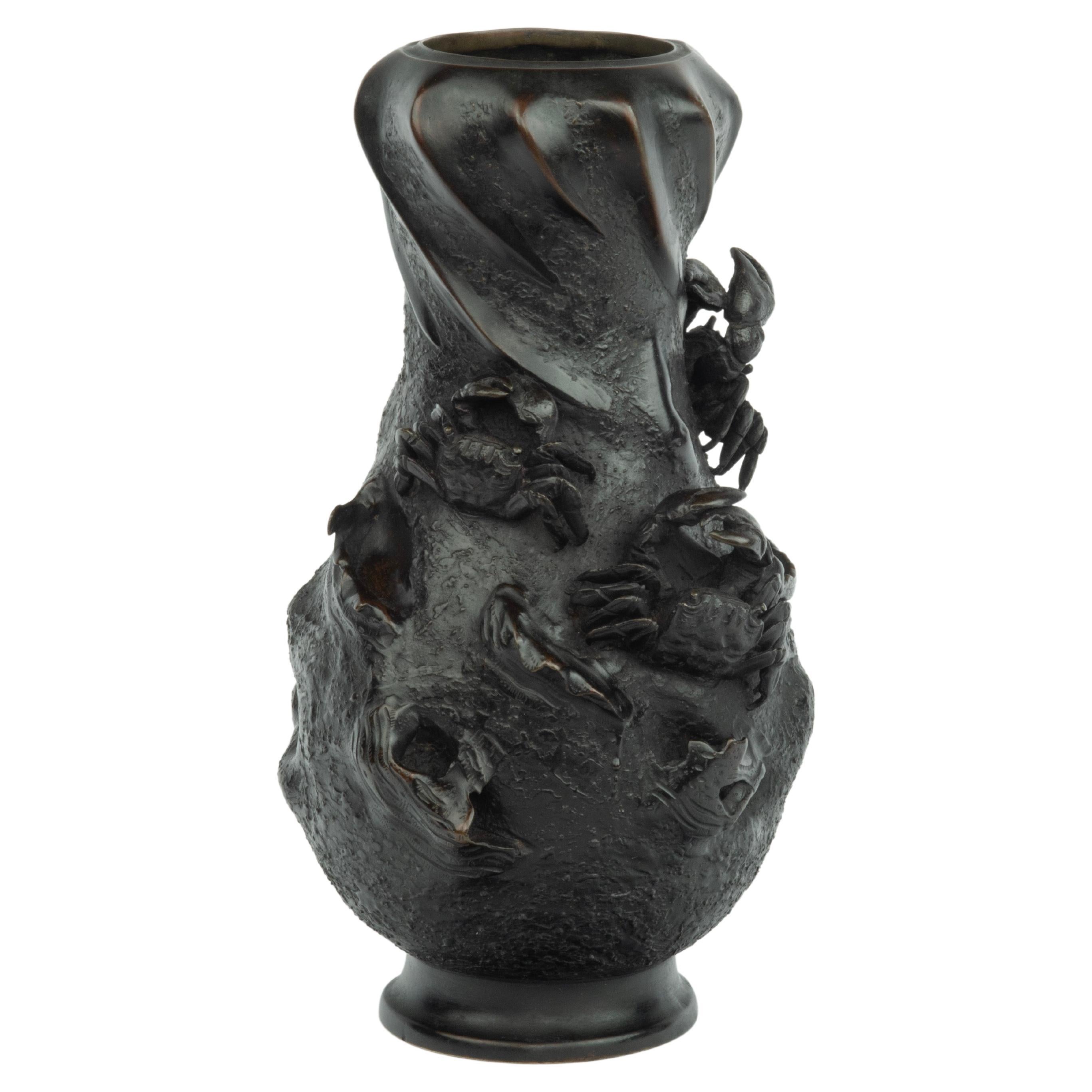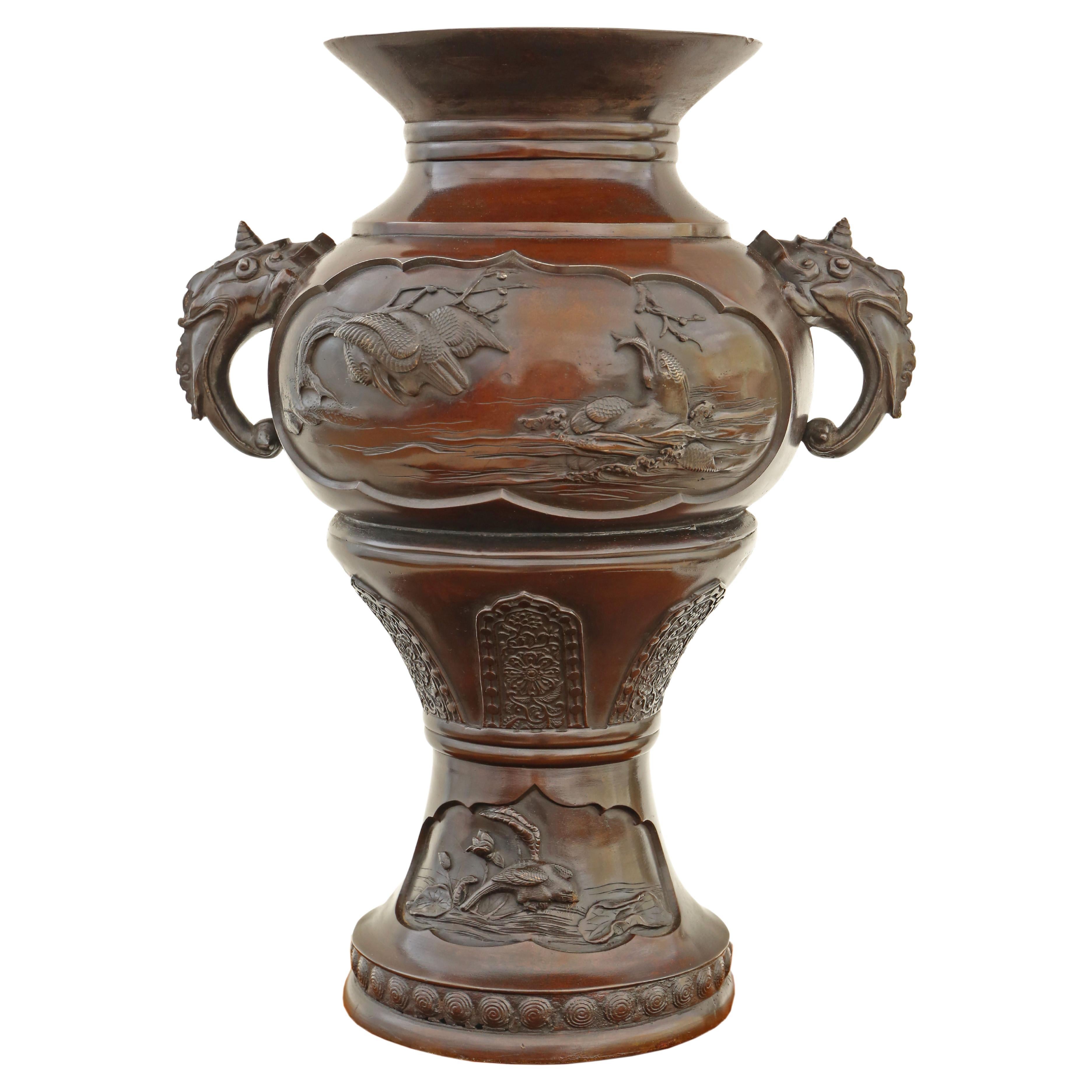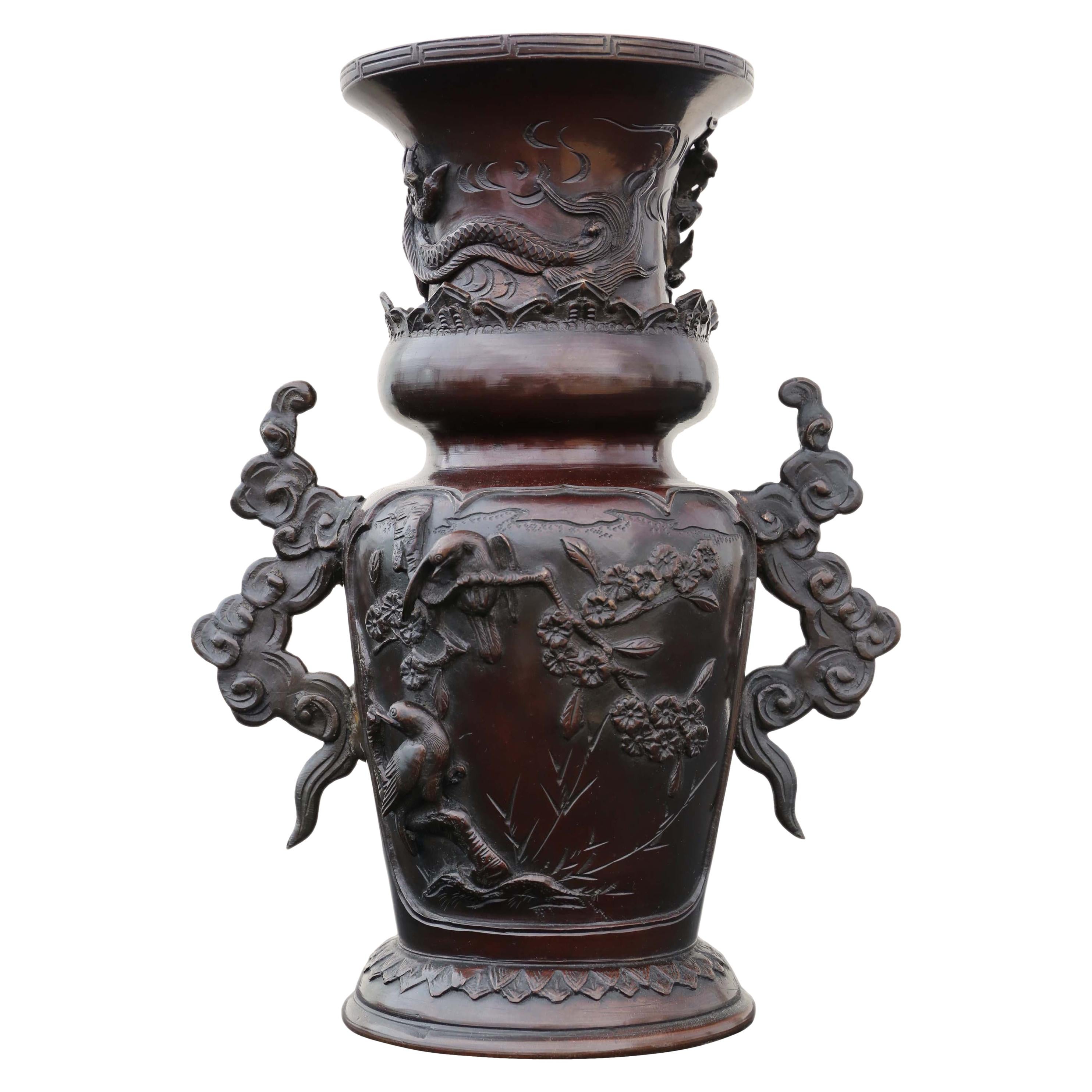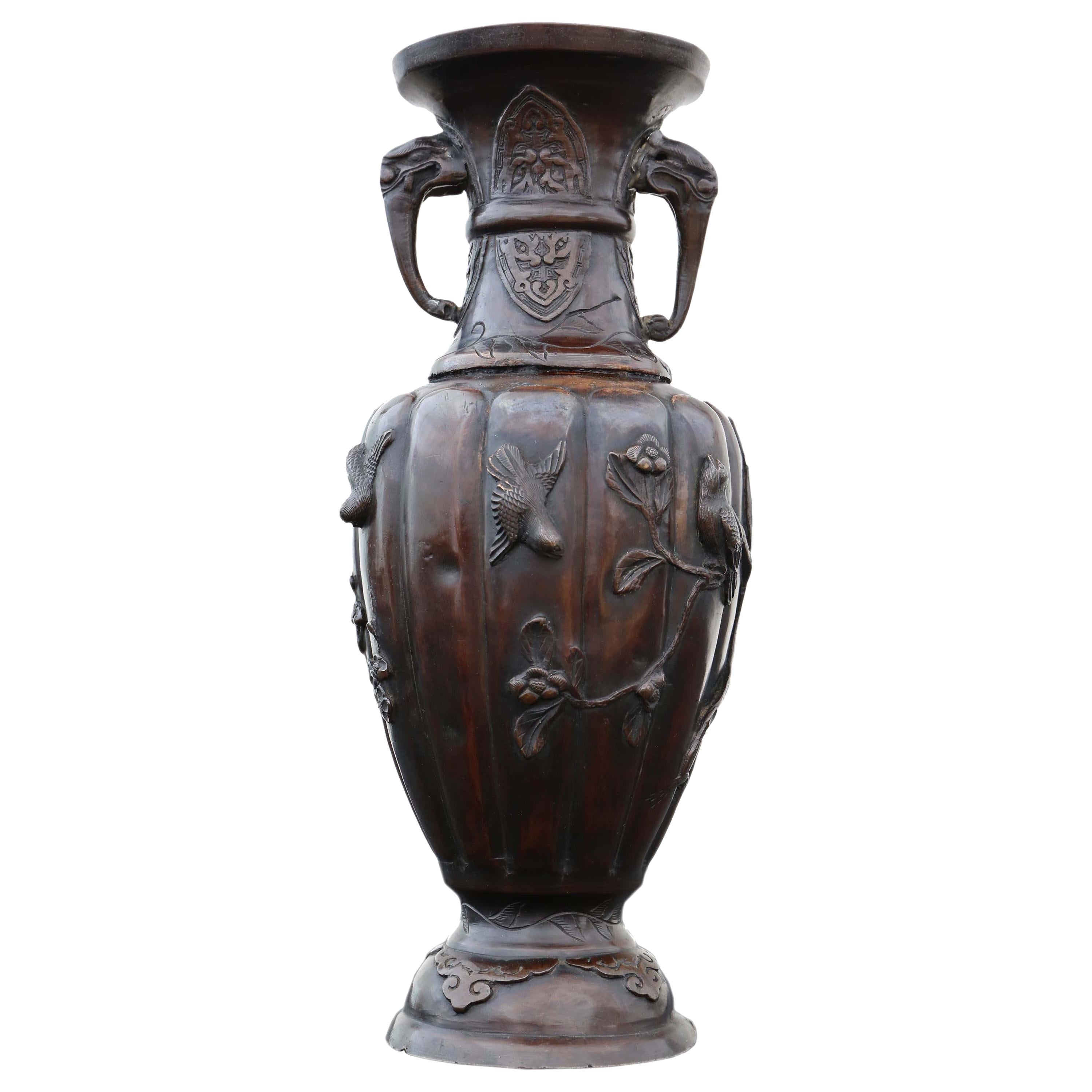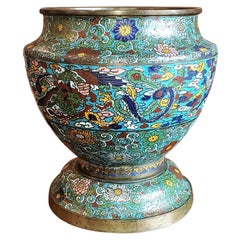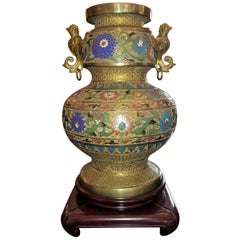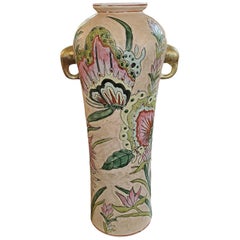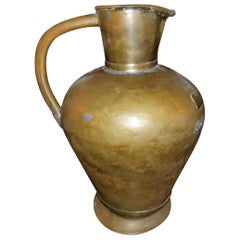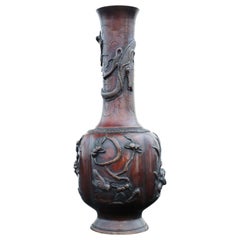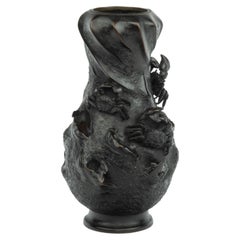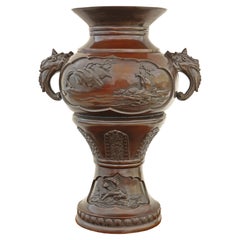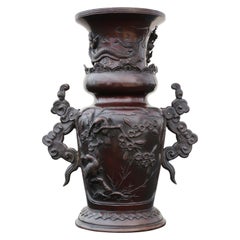Items Similar to Meiji Period High Quality Japanese Bronze Vase by Yoshida Zo
Want more images or videos?
Request additional images or videos from the seller
1 of 21
Meiji Period High Quality Japanese Bronze Vase by Yoshida Zo
$6,000
£4,555.94
€5,210.06
CA$8,382.87
A$9,323.58
CHF 4,868.48
MX$113,458.07
NOK 62,177.98
SEK 58,311.97
DKK 38,884.67
Shipping
Retrieving quote...The 1stDibs Promise:
Authenticity Guarantee,
Money-Back Guarantee,
24-Hour Cancellation
About the Item
PRESENTING a GORGEOUS and EXTREMELY RARE Meiji Period High Quality Japanese Bronze Vase by Yoshida Zo.
Made in Kyoto, Japan circa 1885, by the famous bronze sculptor, Yoshida Zo.
It is a large (20 inches tall) bulbous shaped vase with elongated fluted neck. Made of tin/copper based bronze and brass base, with EXTREMELY HIGH QUALITY dragon and bird appliques.
In the style of archaistic Japanese bronzes but definitely late Meiji Period, as Yoshida Zo of Kyoto sculpted in the mid-late 19th Century.
Has the fully authentic impressed mark/seal of Yoshida Zo on the base.
The vase stands on a tiered circular platform base with chased floral decoration around the central portion.
Moving upwards, the vase has a large bulbous central section with a diameter of 10 inches. It has clouds and other chased decoration all over and 2 large recessed panels with applied bronze appliques of birds, branches, bamboo and cherry blossom flowers.
3 birds on each panel (total of 6) and we think they are ”Oriental Turtle Doves’.
The ‘detail’ to these birds and vegetation appliques is FANTASTIC!
The birds feathers, heads, tails etc are very detailed, as are the flowers and branches etc.
It is this attention to ‘detail’ that really makes this piece stand out as being of the HIGHEST QUALITY!
The vase extends upwards from the bulbous center, to a long-necked and fluted top section which widens to a scalloped open top, with a diameter of 5.3 inches.
The central and long-necked sections are separated with a bronze applique of a ‘coiled dragon’ holding a gourd. This dragon encircles the vase with extended claws.
The long-necked section, likewise, has a bronze applique of a ‘coiled dragon’, encircling the vase with extended claws. This section also has chased or engraved clouds all over.
Again, the QUALITY of the detail to the dragons is breathtaking! The heads, scales, legs, tails and large claws are of exceptional detail and quality.
CONDITION: Mostly in very good original condition. No losses to bird or dragon appliques. Central bulbous section has suffered a few ‘dings’ and ‘dents’ on one side only. 3 dents in total (see pics). Was always constructed in 2 pieces, with the long-necked top section attached to the bulbous base. Some very minor repairs at the point of attachment but not noticeable. The pricing reflects these issues and if it were ‘mint’ it would easily, be worth double the asking price.
Pieces of this quality and size, by Yoshida Zo, RARELY appear on the market. From our extensive research only 1 piece has appeared in the last 20 years at the major auction houses and it was at Sotheby’s in London in 2021, a Bronze Jardiniere, that had an Auction estimate of 2,000-3,000 GBP and sold for 2,142 GBP. Almost $3,000 (USD).
The stamp on the bottom of this beautiful vase is Yoshida zô’ (made by Yoshida (in) the western capital). Seikyo is an alternative name for Kyoto. The workshop of Yoshida in Kyoto was already active during the early Meiji period, producing bronze jardinières (suiban), vases, gongs and ornaments for both domestic and export markets. Yoshida’s Kyoto bronze ware workshop is well known for producing items of extremely high quality. His work was shown at the 1876 International Exhibition in Philadelphia.
Provenance: From a Private LA Collection
Condition: See full listing. Good.
Dimensions: Base diameter of 6.75 inches. Central section is 10 inches in diameter. Top opening has a diameter of 5.3 inches. 20 inches Tall. Weighs 14 lbs.
- Dimensions:Height: 20 in (50.8 cm)Width: 10 in (25.4 cm)Depth: 10 in (25.4 cm)
- Style:Archaistic (In the Style Of)
- Materials and Techniques:
- Place of Origin:
- Period:
- Date of Manufacture:1885
- Condition:Repaired: See full listing. Wear consistent with age and use. Minor losses. Minor structural damages. Minor fading.
- Seller Location:Dallas, TX
- Reference Number:1stDibs: LU3978138326932
About the Seller
4.9
Vetted Professional Seller
Every seller passes strict standards for authenticity and reliability
Established in 2015
1stDibs seller since 2018
390 sales on 1stDibs
Typical response time: 1 hour
- ShippingRetrieving quote...Shipping from: Dallas, TX
- Return Policy
Authenticity Guarantee
In the unlikely event there’s an issue with an item’s authenticity, contact us within 1 year for a full refund. DetailsMoney-Back Guarantee
If your item is not as described, is damaged in transit, or does not arrive, contact us within 7 days for a full refund. Details24-Hour Cancellation
You have a 24-hour grace period in which to reconsider your purchase, with no questions asked.Vetted Professional Sellers
Our world-class sellers must adhere to strict standards for service and quality, maintaining the integrity of our listings.Price-Match Guarantee
If you find that a seller listed the same item for a lower price elsewhere, we’ll match it.Trusted Global Delivery
Our best-in-class carrier network provides specialized shipping options worldwide, including custom delivery.More From This Seller
View AllJapanese Meiji Champleve and Bronze Urn
Located in Dallas, TX
Presenting a gorgeous Japanese Meiji Champleve and bronze urn.
Made in Japan during the Meiji Period circa 1880.
The body of ...
Category
Antique Late 19th Century Japanese Meiji Metalwork
Materials
Bronze, Enamel
Large Oriental Champleve Urn on Stand
Located in Dallas, TX
PRESENTING a BEAUTIFUL and VERY HIGH QUALITY Large Oriental Champleve Urn on Stand.
Early 20th Century, circa 1910 – 20.
Probably Japanese.
Marked, but we cannot decipher the mark...
Category
Early 20th Century Japanese Japonisme Metalwork
Materials
Brass, Bronze, Enamel
Nippon Art Nouveau Style Butterfly Vase
Located in Dallas, TX
Presenting a gorgeous Nippon Art Nouveau style butterfly vase.
Fully marked on base for having been made and hand decorated in Japanese Macau. This h...
Category
Mid-20th Century Macanese Art Nouveau Porcelain
Materials
Porcelain
19th Century Large Civil War Era Bronze and Tin Pitcher
Located in Dallas, TX
Presenting a fabulous historic treasure of times past, namely, a 19th century large Civil War Era bronze and tin pitcher.
From circa 1850, this is an American frontier piece.
I...
Category
Antique Mid-19th Century American American Classical Pitchers
Materials
Brass, Bronze, Copper, Tin
Mid Century Steuben Palace Vase
By Steuben Glass
Located in Dallas, TX
PRESENTING A LOVELY Mid Century Steuben 8.5 inch Palace Vase.
Made by the renowned and highly desirable ‘Steuben’ Glass Works in NY circa 1960-80.
In near mint condition with no chips or cracks.
The vase has a bulbous mid section with swan neck, hence the name (after Asian Palace Vase...
Category
Mid-20th Century American Mid-Century Modern Vases
Materials
Crystal
Large Vintage Japanese Bronzed Sculpture of Toba on His Mule
Located in Dallas, TX
Presenting a beautiful large vintage Japanese bronzed sculpture of Toba on his Mule.
Some might say ‘Monumental’ .. being 34 inches tall ...
Category
Mid-20th Century Japanese Japonisme Sculptures and Carvings
Materials
Bronze, Iron
You May Also Like
Antique Meiji Period Japanese Bronze Vase
Located in Wisbech, Cambridgeshire
Japanese Meiji period bronze vase.
Would look amazing in the right location. The very best color and patina.
Overall maximum dimensions: 31 cm high x 14 cm diameter (inner mouth 4....
Category
Antique 19th Century Meiji Vases
Materials
Bronze
$954 Sale Price
30% Off
A Meiji bronze vase by Nobuhira
Located in Lymington, Hampshire
A Meiji bronze vase by Nobuhira, of baluster shape with a spirally twisted neck, the body decorated with four high relief crabs and several partially...
Category
Antique 1890s Japanese Meiji Metalwork
Materials
Bronze
Antique Large Fine Quality Japanese Oriental Bronze Urn Vase Meiji Period
Located in Wisbech, Cambridgeshire
Antique large 17" fine quality Japanese Oriental bronze urn vase Meiji Period 19th century. Signed artist piece.
Would look amazing in the right location and make a fabulous centr...
Category
Antique 19th Century Metalwork
Materials
Bronze
$1,146 Sale Price
30% Off
Antique Japanese Bronze Vase Early Meiji Period
Located in Wisbech, Cambridgeshire
Early Japanese Meiji period bronze vase. Raised dragon with birds and cloud handles.
Would look amazing in the right location. The very best color an...
Category
Antique 19th Century Meiji Vases
Materials
Bronze
$954 Sale Price
30% Off
Antique Japanese Bronze Vase Meiji Period
Located in Wisbech, Cambridgeshire
Japanese Meiji period bronze vase with bird and foliage decoration and elephant handles, circa 1900.
Would look amazing in the right location. The very best color and patina.
Overa...
Category
Antique 19th Century Meiji Vases
Materials
Bronze
$954 Sale Price
30% Off
Late 19th Century Chinese Bronze Vase
Located in Chapel Hill, NC
Late 19th century Chinese bronze vase, signed. Qing dynasty. Warmly patinated bronze. The handles are archaic elephant heads with rings. The base ...
Category
Antique Late 19th Century Chinese Qing Vases
Materials
Bronze
More Ways To Browse
Cast Bronze Panel
Bronze Applique
Claw Bronze
Bronze Doves
Japanese Brass Vase
Bronze Flute Sculptures
Japanese Bamboo Vase
Japanese Meiji Carving
Engraved Brass Vase
Brass Gong
Asian Dragon Sculpture
Gold Dragon Sculpture
Large Bronze Bird Sculptures
Bronze Dragon Vase
Japanese Applique
Meiji Bronze Sculptures
Japanese Vase With Stamp
Antique Brass Gong
